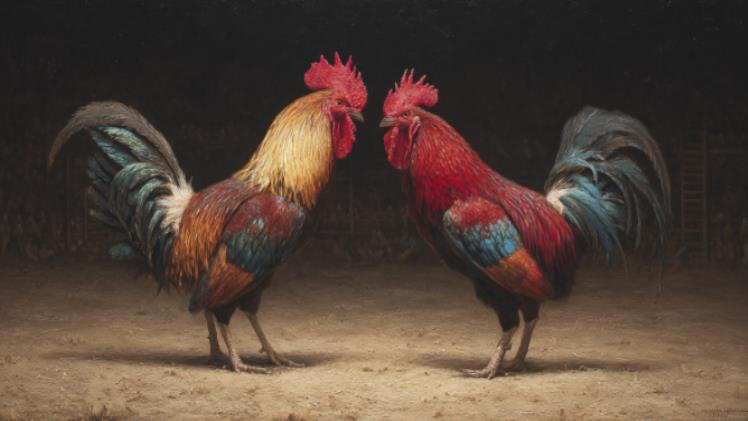The Thrill of Live Cockfighting – A Spectacle of Courage
The world of Live Cockfighting is a complex and often controversial arena, steeped in tradition yet fraught with ethical debate. This ancient practice, which involves two roosters fighting each other, has captivated audiences for centuries, drawing crowds to witness what many consider a display of raw, unadulterated courage and instinct. Understanding the nuances of Live Cockfighting requires looking beyond its surface-level brutality and delving into its cultural significance, the intricate breeding practices, and the passionate communities that surround it.
>>> Đá Gà Trực Tiếp
Live Cockfighting
The allure of Live Cockfighting lies in its primal nature, a spectacle that taps into deeply ingrained human fascination with combat and the natural world. It’s an event where the breeding, training, and sheer will of two gamecocks are put to the ultimate test. Beyond the immediate action, a rich tapestry of history, culture, and economics is interwoven. Enthusiasts often speak of the breeding lines, the careful selection of birds with superior genetics for aggression, stamina, and resilience, and the dedicated training regimens designed to hone these natural attributes. This isn’t merely about pitting animals against each other; for its proponents, it’s about an art form, a dedication to animal husbandry, and a preservation of what they see as a noble, albeit brutal, tradition. The anticipation before a match, the roar of the crowd, and the strategic maneuvering of the handlers all contribute to an atmosphere that is both electrifying and, to outsiders, often perplexing.
>>> video đá gà
The Art of Breeding and Training
The foundation of successful Live Cockfighting rests squarely on the shoulders of dedicated breeders and trainers. These individuals are akin to artisans, meticulously selecting parent stock based on generations of proven lineage. They seek out roosters with a specific temperament – aggressive, intelligent, and possessing remarkable stamina. This selective breeding process is not a haphazard affair; it’s a science and an art combined, aimed at producing birds that are not only physically capable but also possess the psychological fortitude to endure intense combat. Training then becomes a crucial phase, focusing on conditioning the birds for peak physical performance. This involves rigorous exercise routines, specialized diets to optimize muscle development and energy levels, and simulated sparring sessions to sharpen their fighting instincts. The goal is to ensure the roosters are at their absolute best, ready to showcase their inherent fighting prowess when the moment arrives. The dedication involved is immense, often spanning years of planning and execution, with each bird representing a significant investment of time, knowledge, and passion.
The Spectacle and Its Supporters
The atmosphere surrounding Live Cockfighting events is undeniably charged. Enthusiasts describe it as a unique social gathering, a place where like-minded individuals can share their passion and expertise. The betting aspect, while controversial, is an integral part of the spectacle for many, adding an extra layer of excitement and engagement. Supporters often argue that the birds are bred for this purpose, and that the practice, when conducted with certain codes of conduct, is no more cruel than other forms of animal sports that are widely accepted. They might emphasize the care and attention given to the birds, contrasting it with the perceived neglect in factory farming or other industries. For these individuals, Live Cockfighting is a tradition passed down through generations, a cultural practice that holds significant meaning within their communities. The roosters themselves are often viewed with respect, seen as courageous warriors whose brief but intense lives are lived to their fullest potential in the arena.
Ethical Considerations and Legal Battles
Despite its deep roots in certain cultures, Live Cockfighting faces significant opposition and legal challenges. Animal welfare organizations and a growing segment of the public condemn the practice as inherently cruel and inhumane. The debate centers on whether it is morally justifiable to inflict harm on animals for entertainment or profit, regardless of tradition or breeding practices. Many jurisdictions have outlawed Live Cockfighting, leading to clandestine operations and ongoing legal battles. Critics highlight the injuries sustained by the birds, the potential for disease transmission, and the gambling-related criminal activities that can sometimes accompany these events. The contrasting viewpoints create a complex ethical landscape, forcing a societal reckoning with the boundaries of animal welfare and the preservation of cultural practices that inflict suffering. The inherent risk and the potential for severe injury or death to the animals form the core of the arguments against the continuation of such events.
Cockfighting with knives.
The intensification of Cockfighting with knives elevates the debate surrounding the practice to an even more visceral and ethically challenging level. This variation, where razor-sharp blades are affixed to the legs of the fighting cocks, dramatically increases the potential for severe injury and a quicker, often more brutal, conclusion to the contest. The introduction of weaponry transforms the already contentious spectacle into something far more graphic, sparking heightened concern from animal welfare advocates and leading to stricter legal enforcement in many regions. The sheer speed and lethality that Cockfighting with knives can introduce are undeniable, making it a focal point for those who seek to abolish all forms of animal combat sports.
The Evolution of Lethal Combat
The incorporation of knives in Live Cockfighting represents a significant, and for many, a disturbing, evolution of the sport. Historically, cockfighting relied purely on the natural weaponry of the roosters – their spurs. The advent of attaching blades, typically made of metal or sharpened bone, to the birds’ legs fundamentally alters the dynamic of the fight. These additions are designed to inflict deeper, more lacerating wounds, leading to a faster and more decisive outcome. This shift from a contest of endurance and natural aggression to one augmented by artificial weaponry raises profound ethical questions. Proponents might argue that it simply makes the contest more exciting or that it’s a natural progression for those seeking a more intense experience. However, critics argue that it crosses a critical ethical threshold, turning a display of animal instinct into an instrument of amplified suffering. The precision and sharpness of these knives mean that even a single well-placed blow can be fatal, drastically shortening the birds’ lives and intensifying the violence.
The Brutality and its Ramifications
The inherent brutality of Cockfighting with knives is undeniable. The blades, often referred to as “gaffs,” are designed to cause maximum damage, leading to severe bleeding and rapid incapacitation. This form of the sport is not about the nuanced display of a rooster’s fighting spirit; it’s about a swift, often gory, confrontation. The sight of blood and the graphic injuries sustained by the birds are deeply disturbing to many, fueling the arguments for its complete eradication. Beyond the immediate suffering of the animals, there are also concerns about the potential for infection that can arise from such deep wounds, even if the bird survives the initial encounter. The speed at which these fights can conclude also means that the careful breeding and training that go into a rooster might be negated by a single, lucky or unlucky, strike from a blade. This makes the entire endeavor seem even more gratuitous to opponents. The amplified violence inherent in Cockfighting with knives is a primary reason for its widespread condemnation and legal prohibition in many parts of the world.
Legal Scrutiny and Underground Operations
Due to its extreme nature, Cockfighting with knives often attracts the most intense legal scrutiny. Law enforcement agencies worldwide crack down heavily on any activities involving the use of blades in cockfights. This often drives such operations underground, making them harder to monitor and potentially more dangerous. These clandestine events can be associated with organized crime, illegal gambling rings, and a general disregard for animal welfare and public safety. The secrecy surrounding these operations means that the conditions under which the birds are kept and fought can be abysmal, with little regard for hygiene or veterinary care. The high stakes involved in illegal gambling can also lead to desperate measures, where the welfare of the animals is completely secondary to the financial outcomes. The fight against Cockfighting with knives is therefore not just about animal cruelty; it’s also about combating broader criminal enterprises that thrive in the shadows.
| Category | Description | Ethical Concerns | Legal Status (General) |
| Live Cockfighting (Natural Spurs) | Two roosters fight using their natural leg spurs. | Concerns about animal suffering, potential for injury, and the ethics of animal combat for sport/gambling. | Banned in many countries, but legal in some regions with varying regulations. |
| Cockfighting with knives (Gaffs) | Two roosters fight with sharpened blades (gaffs) attached to their legs. | Amplified suffering, increased lethality, graphic violence, and potential for severe, life-threatening wounds. | Widely banned globally due to extreme cruelty and enhanced lethality. |
The Future of the Spectacle
The future of Live Cockfighting, especially in its more violent forms like Cockfighting with knives, appears increasingly precarious. The global trend is towards greater animal welfare protections, and practices that involve deliberate infliction of harm are coming under increasing pressure. While proponents may cling to tradition and the perceived nobility of the practice, the ethical arguments against it are gaining traction. The legal battles are ongoing, and the societal condemnation is growing louder. It remains to be seen whether any form of cockfighting can truly endure in an era that is increasingly sensitive to the rights and welfare of animals. The shift towards outlawing even natural spur fights suggests that the introduction of knives is a line that most societies are unwilling to cross, pushing these brutal spectacles further into illegality and away from any semblance of regulated practice.
Conclusion
The world of Live Cockfighting, from its traditional form using natural spurs to the more extreme variant of Cockfighting with knives, presents a deeply divisive issue. While proponents often cite cultural heritage, breeding expertise, and a display of natural animal valor, critics overwhelmingly point to the inherent cruelty, the potential for immense suffering, and the ethical bankruptcy of using animals for sport and gambling. The legal landscape reflects this global unease, with bans becoming increasingly common, though clandestine operations persist, particularly those involving the amplified violence of knives. Ultimately, the trajectory of Live Cockfighting appears to be one of declining societal acceptance, as ethical considerations regarding animal welfare continue to shape global perspectives and legal frameworks, pushing such practices further into the shadows and under intense scrutiny.






